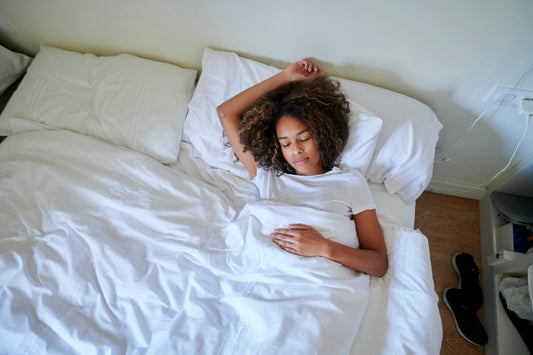4 Steps to Making Your Bedroom Sleep Friendly

If you struggle to get at least seven hours of sleep per night, you’re not alone. Work, family, and financial stress, not to mention medical conditions and physical aches and pains, could all be at the centre of your sleeplessness.
Your sleep environment, yes, your bedroom, can influence your ability to fall and stay asleep. Give yourself a sleep advantage with a smart bedroom design that helps your mind and body relax.
Lighting Design for Better Sleep
Light, natural light that is, is at the epicentre of the timing of your sleep cycle. During the day, the blue light that filters through the Earth’s atmosphere suppresses sleep hormones. As the light begins to fade, the brain starts prepping for sleep. They’re out in full force by the time it’s dark outside.
But sunlight isn’t the only source of light that can influence the sleep cycle. Any light in the bedroom, both natural and artificial, can either support or get in the way of good sleep. So you’ll need to use your lighting design to your advantage.
Your window treatments, whether they’re shutters, blinds, or blackout curtains, should block out light at night. Any light that seeps through could keep you awake or wake you prematurely.
Stick with incandescent lightbulbs as their high-efficiency counterparts can give off a blue light that’s similar enough to sunlight to delay the sleep cycle. Dimmer switches can also help because you can lower light levels to keep your body in tune with your natural sleep cycle.
Building a comfortable focal point
The largest piece of furniture in a room is often the focal point. Of course, in most bedrooms that would be the bed. It’s both the visual focal point and the focus of your sleep comfort. Your mattress acts as the foundation of that comfort.
It should support – your weight and most common sleep position – stomach, side, or back. Keep in mind that the heavier you are, the firmer your mattress will need to be to keep your spine aligned. If you’re lighter than average, you’ll need a softer mattress.
Natural fibre bedding that allows moisture and heat to move away from the body allows for better temperature regulation. Cotton and linen are excellent choices as they not only let the body breathe but grow softer with each washing.
Temperature as part of design
Most people sleep best in a bedroom that’s kept 15–20 °C, but staying within that range isn’t always easy due to seasonal temperature changes. Designs that enhance ventilation and airflow can help you stay comfortable year round.
Your first option is to either lower or raise the thermostat according to the season. In the summer, try to keep the room temperature from skyrocketing. In the winter, simply set it to keep the room temperature from dropping below 15 °C.
Beyond the thermostat, you can add a stylish ceiling fan. It can keep air flowing over your body so that moisture can evaporate, and you stay comfortably cool. In the winter, wool or knitted blankets will not only keep you warm but create a coziness that will be hard to resist.
The right kind of storage for a decluttered mind
Is your bedroom a catchall space for the items that don’t belong anywhere else? Clutter does more than make your trip from the bed to the bathroom dangerous. It can prevent your mind and body from relaxing. Under-bed storage or a closet organizer can help you get clutter under control so that your possessions aren’t controlling you.
Today, organizational tools like baskets and bins come in creative styles and colours to fully enhance your design aesthetic. And closet organizers are a whole culture unto themselves. They go from basic and simple to elaborate built-ins that create a place for everything.
Sleep Hygiene
It can be difficult to fall asleep when the day’s tasks are done. Too often, we just keep going until we stop, with little transition, and it’s not surprising that sleep may not come easily. That doesn’t mean it needs to be that way; there are things we can do to improve our sleep.
While caffeine is fine in the morning, it can interfere with sleep in the afternoon or evening and should be avoided. Alcohol should also be avoided near bedtime, as it can delay sleep onset and minimize deep sleep.
Regular exercise earlier in the day can help ensure healthy sleep, both from the exertion itself and from the benefits of decreased stress. We can also cultivate healthier sleep patterns by establishing a regular sleep schedule and taking time to wind down before sleep.
Bedtime Routines are Not Just for Kids!
Think of a relaxing activity that may help you wind down, such as reading a book or listening to relaxing music. Stretching and breathing exercises may also be of help. While lying in bed, it may seem relaxing to scroll through social media, but it’s more stimulating than it seems.
The blue light has also been shown to disrupt sleep. It may be challenging at first, but let your phone sleep somewhere else. Your rest will improve, and your body will thank you for it.[1]
Conclusion
You don’t necessarily need to redecorate the entire room. A change in lightbulbs or curtains might be all you need to finally get some shuteye. Take a close look at what you already have and start making small changes.
Design a bedtime routine to support your body’s most basic need – sleep
References :
- Irish LA, Kline CE, Gunn HE, et al. The role of sleep hygiene in promoting public health: A review of empirical evidence. Sleep Med Rev. 2015; 22:23-36.
 Free returns & exchanges
Free returns & exchanges



